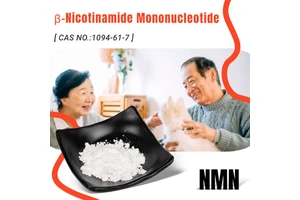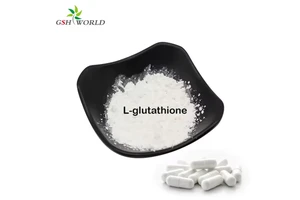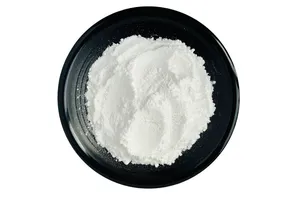Most Comprehensive Glutathione Purchasing Guide for 2025
Introduction
Glutathione (GSH) is a small molecule peptide composed of three amino acids: glutamic acid, cysteine and glycine. It is known as the "parent antioxidant" and is one of the most powerful antioxidant substances in human cells.
With the rise of the "appearance level economy" and health awareness, glutathione has rapidly gained popularity in the oral beauty market, especially being highly sought after for its potential in "whitening" and "anti-aging".
This article will deeply analyze the mechanism of action of glutathione, based on scientific evidence, evaluate its efficacy levels in skin whitening, anti-aging, and liver protection, and provide a comprehensive safety assessment and practical selection suggestions, aiming to help consumers scientifically and rationally understand this popular supplement.
Glutamine-cysteine-glycine is a tripeptide containing thiol groups, which has antioxidant and integrated detoxification effects. Cysteine is the core for maintaining the REDOX state of thiol groups in cells.
mechanism of glutathione
To understand glutathione, we can imagine our bodies as a busy city, and free radicals are the "garbage" and "pollutants" constantly produced during the operation of the city. They attack cells, leading to aging and diseases.
Glutathione plays two key roles in this city:
1. Top-notch cleaners
It can directly "capture" and neutralize free radicals, treating them harmlessly.
Its unique sulfur-containing groups are the key weapons for capturing these harmful substances.
2. Master of Logistics Maintenance
It can also "repair" and "activate" other antioxidants, such as vitamin C and vitamin E.
When these antioxidants consume themselves in battle, glutathione can restore their combat effectiveness and continue to protect the body.
Glutathione is targeted at whitening
Its working principle is like a "pigment factory" that regulates the skin:
Inhibit key enzymes: It can inhibit the activity of tyrosinase, which is the most crucial enzyme in the process of melanin production. It's like slowing down the operation of the machines in a pigment factory.
Change the product type: It can guide the production path of melanin, shifting from generating dark "Eumelanin" to light yellow "Phaeomelanin".
This is like asking factories to reduce the production of dark ink and instead produce light-colored ink, thereby making the skin tone look brighter.
Glutathione targets the liver
Glutathione is a core employee of the "Detoxification Center".
The liver is the detoxification organ of the human body. Glutathione is deeply involved in the second stage of the detoxification process and can combine with various foreign toxic substances (such as alcohol metabolites, drugs, and heavy metals), increasing their water solubility and making them easier to be excreted through urine.
Main efficacy and scientific evidence level analysis
1. Skin whitening and brightening
Efficacy description: By inhibiting the key enzymes involved in melanin production, reducing melanin deposition, and guiding pigments towards lighter types, it helps to brighten and even out skin tone, potentially reducing pigmentation and improving dullness.
Evidence analysis: Mechanistically, glutathione can inhibit the activity of tyrosinase by binding to copper ions, which is the "rate-limiting step" in melanin synthesis.
It can direct the synthesis path of melanin from the production of dark "eumelanin" to the production of light yellow "brown melanin".
At the animal level, as shown in the zebrafish experiment, glutathione yeast extract could significantly inhibit melanin formation.
At the human level, a clinical study involving 30 women demonstrated that after taking 50mg of glutathione orally for 8 consecutive weeks, the skin's brightness value (L value) significantly improved. Moreover, after ultraviolet radiation, the skin's moisture retention ability and erythema recovery rate were also superior to those of the placebo group.
Evidence level: Grade B (Preliminary evidence/potential)
Reason: The biological mechanism is clear and has received strong support from in vitro and animal experiments.
The key point is that its effect has been verified in preliminary human clinical trials and positive changes have been observed in key biomarkers such as skin brightness L value.
To achieve Grade A, larger-scale, multi-center, long-cycle randomized controlled trials (RCTS) are still needed to confirm the universality and stability of its whitening effect in different populations.
2. Antioxidant and anti-aging
Function description: As the most powerful "maternal antioxidant" within cells, it can directly eliminate free radicals and regenerate other antioxidants (such as vitamin C/E), thereby protecting cells from oxidative damage. This is regarded as the core mechanism for delaying the aging process.
Evidence analysis: Mechanologically, glutathione is the core of the human antioxidant defense system, and its significance is a consensus in the field of biochemistry.
Studies at the cellular level have shown that glutathione yeast extract (FHG) can significantly improve the survival rate of fibroblasts damaged by ultraviolet rays and can significantly enhance the synthesis of collagen, which is directly related to skin aging.
Evidence level: Grade A (as a core antioxidant in the body) Grade C (Clinical Anti-aging effects of Oral supplements)
Reason: The status of glutathione as an endogenous core antioxidant within cells is supported by A vast amount of basic scientific research, with conclusive evidence (Grade A).
The evidence for directly equating "oral supplements" with "clinically visible anti-aging effects (such as a significant reduction in wrinkles)" is currently insufficient (Class C).
The current evidence mainly remains at the cellular experiment level, lacking long-term, high-quality human randomized controlled trials that show oral supplementation can directly reverse or significantly delay visible signs of skin aging.
3. Protect the liver
Function description: Deeply involved in the liver's detoxification process, it helps neutralize and eliminate alcohol, drug and environmental toxins, thereby reducing the burden on the liver, protecting liver cells and assisting in maintaining liver health.
Evidence analysis: Mechanically, glutathione is a key substance for the liver's second-stage detoxification. It can combine with various toxins, enhancing their water solubility and facilitating their excretion from the body.
In terms of animal experiments, it has been shown that in a mouse model of alcoholic liver injury, supplementing glutathione can significantly reduce fat deposition and inflammation levels in the liver.
In human studies, Annex II (P33-38) presents multiple pieces of evidence: One trial demonstrated that taking 100mg of glutathione before drinking alcohol can accelerate the clearance of alcohol in breathing;
Another 8-week trial found that daily supplementation of 50mg of glutathione could significantly reduce the levels of key enzyme indicators reflecting liver stress in the subjects - aspartate aminotransferase (AST) and alanine aminotransferase (ALT).
Evidence level: Grade B (Preliminary evidence/potential)
The reason is that its biological mechanism in liver detoxification is very clear. The protective effect of animal experiments is remarkable. Most importantly, multiple small-scale human clinical trials have confirmed its positive impact on liver function from multiple perspectives (alcohol metabolism rate, liver enzyme levels).
However, to reach grade A, larger-scale randomized controlled trials are needed to confirm its clear clinical therapeutic or preventive value for specific liver diseases, such as non-alcoholic fatty liver disease.
Safety and risk assessment
Drug or supplement interactions: Currently, there are relatively few known clear drug interactions.
However, theoretically, due to its powerful detoxification function, it may affect the efficacy of certain drugs (especially chemotherapy drugs). Therefore, it is essential to consult a doctor before using it during the medication period.
Common side effects: Oral glutathione is generally considered safe and well tolerated.
At the recommended dose, side effects are rare. A small number of people may experience mild gastrointestinal discomfort, such as bloating or diarrhea.
How to Choose and Use Glutathione (Practical Guide)
Best Form/How to choose:
Reduced form (L-Glutathione) : This is the most common and extensively studied form, and it is also the biologically active form.
S-Acetyl-Glutathione/Liposomal Glutathione: One of the main challenges of oral glutathione is its low bioavailability in the intestinal tract.
S-acetyl and liposome forms are regarded as improved types. Theoretically, they can be better absorbed through the intestinal tract and enter cells to exert their functions, but they are usually more expensive.
Yeast-derived glutathione: Glutathione is enriched through the fermentation of specific yeasts and is a natural form of food source, usually coexisting with other nutrients such as B vitamins.
Natural food sources: Although the amount obtained directly from food is limited, one can consume more foods rich in glutathione, such as asparagus, avocado, spinach, okra, etc.
Eating more foods rich in its synthetic raw materials (sulfides, selenium), such as cruciferous vegetables (broccoli, cabbage), garlic, Onions, eggs and nuts, can also promote the body's own synthesis.
Suggested usage:
Suggested dosage: The daily intake limit recommended by Taiwan's Ministry of Health and Welfare is 250 milligrams.
Based on multiple studies, the dosage range for specific purposes can be between 50 and 500 milligrams per day.
Exceeding the recommended dosage does not bring additional benefits because the body cannot absorb the excess.
Time and method of taking: Some suggestions suggest that taking it on an empty stomach is better for absorption, while others recommend taking it after meals to reduce potential gastrointestinal discomfort. There is no unified conclusion yet.
When taken together with vitamin C and vitamin E, it may produce a synergistic antioxidant effect.
Conclusion
Glutathione, as the endogenous "mother of antioxidants" in the human body, plays a crucial role in maintaining cellular health, delaying aging and detoxification.
As an oral supplement, it has shown initial but promising scientific evidence in brightening skin tone and assisting liver protection.
Its fundamental role as an antioxidant is beyond doubt.
References
- 1. Gasmi, A., Nasreen, A., Lenchyk, L., Lysiuk, R., Peana, M., Shapovalova, N., Piscopo, S., Komissarenko, M., Shanaida, M., Smetanina, K., Antonyak, H., Fira, L., Lykhatskyi, P., Fira, D., & Bjørklund, G. An Update on Glutathione's Biosynthesis, Metabolism, Functions, and Medicinal Purposes.. Current medicinal chemistry. 2023 https://doi.org/10.2174/0109298673251025230919105818
- 2. Tan, M., Yin, Y., , X., Zhang, J., Pan, W., Tan, M., Zhao, Y., Yang, T., Jiang, T., & Li, H. Glutathione system enhancement for cardiac protection: pharmacological options against oxidative stress and ferroptosis. Cell Death & Disease. 2023; 14. https://doi.org/10.1038/s41419-023-05645-y
- 3. Vašková, J., Kočan, L., Vaško, L., & Perjési, P. Glutathione-Related Enzymes and Proteins: A Review. Molecules. 2023; 28. https://doi.org/10.3390/molecules28031447
- 4. Cassier-Chauvat, C., Marceau, F., Farci, S., Ouchane, S., & Chauvat, F. The Glutathione System: A Journey from Cyanobacteria to Higher Eukaryotes. Antioxidants. 2023; 12. https://doi.org/10.3390/antiox12061199
- 5. Vairetti, M., Di Pasqua, L., Cagna, M., Richelmi, P., Ferrigno, A., & Berardo, C. Changes in Glutathione Content in Liver Diseases: An Update. Antioxidants. 2021; 10. https://doi.org/10.3390/antiox10030364
- 6. Potęga, A. Glutathione-Mediated Conjugation of Anticancer Drugs: An Overview of Reaction Mechanisms and Biological Significance for Drug Detoxification and Bioactivation. Molecules. 2022; 27. https://doi.org/10.3390/molecules27165252
- 7. Minich, D., & Brown, B. A Review of Dietary (Phyto)Nutrients for Glutathione Support. Nutrients. 2019; 11. https://doi.org/10.3390/nu11092073
- 8. Lv, H., Zhen, C., Liu, J., Yang, P., Hu, L., & Shang, P. Unraveling the Potential Role of Glutathione in Multiple Forms of Cell Death in Cancer Therapy. Oxidative Medicine and Cellular Longevity. 2019; 2019. https://doi.org/10.1155/2019/3150145
- 9. Aoyama, K. Glutathione in the Brain. International Journal of Molecular Sciences. 2021; 22. https://doi.org/10.3390/ijms22095010
- 10. Iskusnykh, I., Zakharova, A., & Pathak, D. Glutathione in Brain Disorders and Aging. Molecules. 2022; 27. https://doi.org/10.3390/molecules27010324
- 11. Dwivedi, D., Megha, K., Mishra, R., & Mandal, P. Glutathione in Brain: Overview of Its Conformations, Functions, Biochemical Characteristics, Quantitation and Potential Therapeutic Role in Brain Disorders. Neurochemical Research. 2020; 45. https://doi.org/10.1007/s11064-020-03030-1
- 12. Santacroce, G., Gentile, A., Soriano, S., Novelli, A., Lenti, M., & Di Sabatino, A. Glutathione: Pharmacological aspects and implications for clinical use in non-alcoholic fatty liver disease. Frontiers in Medicine. 2023; 10. https://doi.org/10.3389/fmed.2023.1124275
- 13. Wróblewska, J., Wróblewski, M., Hołyńska-Iwan, I., Modrzejewska, M., Nuszkiewicz, J., Wróblewska, W., & Woźniak, A. The Role of Glutathione in Selected Viral Diseases. Antioxidants. 2023; 12. https://doi.org/10.3390/antiox12071325
- 14. Niu, B., Liao, K., Zhou, Y., Wen, T., Quan, G., Pan, X., & Wu, C. Application of glutathione depletion in cancer therapy: Enhanced ROS-based therapy, ferroptosis, and chemotherapy.. Biomaterials. 2021; 277. https://doi.org/10.1016/j.biomaterials.2021.121110
- 15. Kennedy, L., Sandhu, J., Harper, M., & Čuperlović-Culf, M. Role of Glutathione in Cancer: From Mechanisms to Therapies. Biomolecules. 2020; 10. https://doi.org/10.3390/biom10101429














